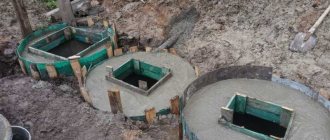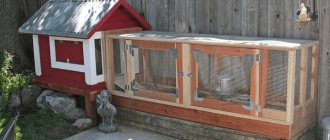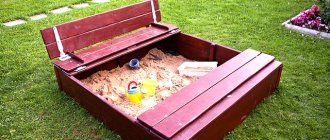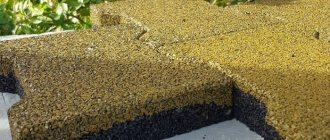Features of creating a country sewer system
To improve a private house, including on a suburban area, it is necessary to lay utility lines. It is known that far beyond the city limits, there are no centralized wastewater disposal systems. The only solution to this problem is to organize an autonomous sewage system in your dacha yourself.
In elite country villages and cottage towns, powerful local treatment plants are installed that can serve several households at the same time, but this rarely happens. Typically, owners of small garden plots with an area of no more than 15 acres give preference to inexpensive objects - cesspools or wastewater treatment plants of simple design. Let's understand local sewerage - what it is, how it works and what advantages it has.
For construction, affordable building or improvised materials are used: white or red bricks, ready-made concrete blanks, tires, plastic tanks, cement mortar and much more.
There is another more expensive option, how to properly install a sewer system in a country house. It involves installing a ready-made, factory-made container made of modified plastic, which is equipped with ventilation, a pipe for connecting to pipes and a technical hatch.
According to current sanitary standards, it is prohibited to use a drainage pit without installing a sealed tank. Otherwise, untreated sewage, containing pathogens and aggressive chemical compounds, pollutes the environment when it enters directly into the soil and groundwater.
There is also no point in installing expensive biological treatment plants, since the amount of waste liquid is usually small, and the treatment facility will be like a storage tank. It turns out that the best option is a large cesspool or a structure such as a septic tank on a summer cottage.
If the area is large, then several cesspools can be installed. They will be, for example, a peat pit for an outdoor toilet, and two storage tanks for a house and a bathhouse.
What to focus on when drawing up a project
Specifics and dimensions of the plot
If it has not yet been inhabited or planted, then the only limitation on the acquisition of a type of local treatment facility is the planned layout of the territory. As a rule, when choosing a septic tank by size, gardeners are guided by the area that they can allocate for it. After all, a dacha is not only a place for relaxation, but also a good help in solving the “food program” for a particular family.
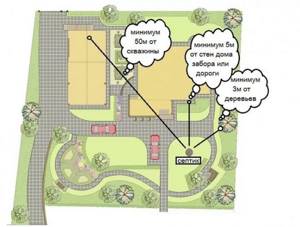
For a site where something is already being grown, the problem of laying a route comes to the fore. Sewage pipes are laid in the ground. And any excavation work in a planted area will inevitably damage some of the roots of fruit bushes and trees. In addition, you will have to change the usual layout and lay out the beds differently.
Advice . In order to save useful space, it is worth paying attention to biotreatment stations. They are fully equipped with everything necessary, and in order to use clarified liquid for household needs (for example, watering plots) or dump it into the ground, no additional equipment is required. In addition, there is no smell from the station.
Features of the house
It’s one thing if it’s a small, simple building, popularly called a “hut.” But there are dachas on 2 or even 3 floors, with several rooms. And in separate rooms there are points for water collection and drainage. This already concerns the question of the capacity of the septic tank and the method of treating wastewater.
Soil characteristics and configuration of underground water layers
The choice of the type of septic tank depends not least on this. For each model, no matter what the managers say, there are certain nuances regarding installation. For example, on problematic soils, which include, for example, clay soils. More about this here. And the close location of underground water to the surface also imposes a number of restrictions.
Convenient access for a sewer truck
The length of her sleeve is not unlimited - up to 25 m, with additional knees (if you focus on the standard). Besides, will she be able to turn around in the country lane? Will it be convenient for the owner to dismantle the perimeter fence and bring equipment onto the site if the season is in full swing and everything is growing and bearing fruit in the garden beds?
Advice . The acquisition of a biorefinery station automatically removes all these problems from the agenda.
Features of using a dacha
You only need to answer 3 basic questions.
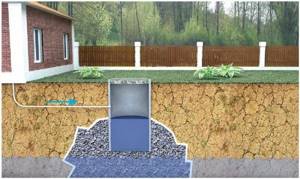
- For permanent residence or is visited by the owners only during the season.
- How many people (on average, over a certain period) are at the dacha at the same time?
- Are there household appliances in the house that require running water, how many of them are there, how often (and for how long) are they used?
Variety of sewer system schemes
They can be very different, depending on the number of users, including temporary ones, the presence of plumbing fixtures, the volume of waste liquid, and the number of points connected to the sewer system.
The following parts of the structure may differ in their characteristics:
- internal sewerage distribution at the dacha;
- type of pit or septic tank;
- pipeline - it can be simple or branched.
There are several popular schemes. Modern country houses bear little resemblance to barns. Even on small suburban plots, owners are building high-quality two-story houses.
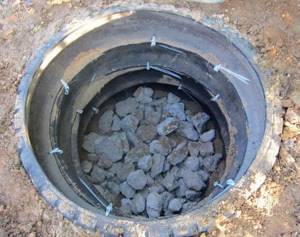
The optimal scheme for laying a sewer system in a dacha for such a structure consists of a toilet room and a bathroom on the second floor, and a kitchen on the first floor. In this case, pipes from plumbing fixtures are routed to a riser located near the wall close to the septic tank.
In one-story houses with a small area, as a rule, a set consisting of a toilet and sink is installed. A shower, even if available, is usually placed outside, near the gardening area. Toilet waste that enters the inner pipe is discharged outside the building, from where it is sent to the septic tank.
The cesspool is often located near the house at a distance of 5 - 10 meters. According to sanitary standards, it is not equipped closer than 5 meters. If placed further than 10 meters, then difficulties may arise in the process of laying the pipeline.
The fact is that in order to ensure the movement of waste liquid by gravity, it is necessary to maintain a slope of 2 centimeters per 1 meter of the line. This means: the further away the cesspool is, the deeper you need to dig a trench for laying pipes. But it is inconvenient to maintain a container that is mounted too deeply during operation.
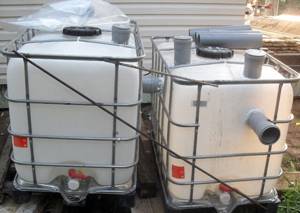
Increasingly, country property owners prefer to build a two-chamber septic tank or cesspool with an overflow into a filter well. In this case, calling the vacuum cleaners will also be required, but this will happen much less frequently.
The most common do-it-yourself sewerage schemes in the countryside are supplemented with external or internal branched wiring, connecting a larger number of waste discharge points, a more efficiently functioning septic tank and filtration field.
Sewage device
making a cesspool for sewage is not such an easy task, so many resort to the decision to buy a ready-made container. Mostly barrels with a volume of 200-300 liters are used.
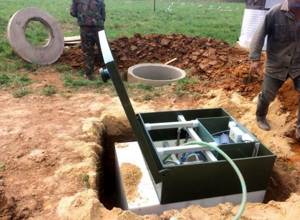
Plastic barrels are more expensive, but they have excellent characteristics, one of the main ones is that they are not subject to corrosion. That is why such barrels can be used for decades.
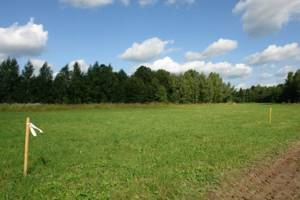
Purchase and inspection of land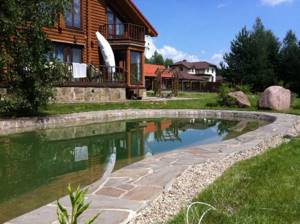
How to make drainage on a site - the secrets of a master on how to make drainage to drain water yourself!
- How to clean a pond: a detailed description of how to clean a pond quickly and easily with your own hands (130 photos + video)
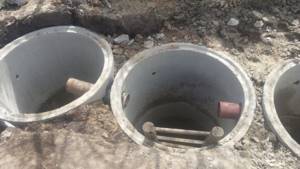
If you only have steel barrels, then bitumen mastic will help you. She needs to treat the barrel outside and inside; after such a process, rust is definitely not scary for her.
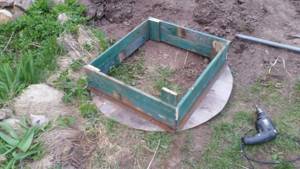
Development of a project based on standards
When a complete option for arranging a local sewer system is selected, to obtain a high-quality result it is necessary to carry out the correct design either independently or by engineers.
The first option is possible if you plan to have the simplest sewage system at your dacha yourself without building complex structures - a septic tank, a filtration well, a filtration field.
For example, on the site it is planned to build an outdoor toilet of the “birdhouse” type, which will also serve as a place where household waste is disposed of, and instead of full-fledged hand and dishwashing facilities, it was decided to install a very ordinary washbasin. To build such a toilet on the street, all you need to do is dig a hole, place a sealed tank in it, decide on the optimal layout of the structure and sign an agreement with the sewer company on the regular removal of sewage.
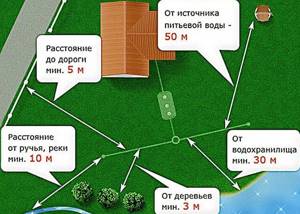
If you are planning a complex country sewer system with in-house wiring, a septic tank, laying pipes from the house, summer kitchen and bathhouse, the best solution would be to seek the services of design engineers. It is a professional approach that will allow you to have a correctly drawn up project, taking into account the layout of the house and the surrounding landscape.
In both cases, when building a drainage pit or septic tank, one should take into account SanPiN standards, according to which the distance from the container intended for collecting wastewater and sewage to nearby objects depends on the composition of the soil. For example, the gap between the septic tank and the well or borehole should be 25 - 30 meters for clay soils, and at least 50 meters for sandy loam and sandy soils.
When installing a septic tank at your dacha with your own hands, first of all, after developing the project, you need to select plumbing and sewerage equipment, based on the technical conditions and GOST standards regulating the use of certain materials.

Thus, when laying an external section of a sewer main, you should use exclusively special external pipe products, which include smooth and corrugated products made from HDPE, PP and PVC. Fittings for them must match the purchased pipes in diameter and material.
Electricity
All issues regarding electricity connection (coordination, power allocation, payment) must be resolved with the local electricity supply organization. Connection to the grid will depend on how far the house is located from the main power distribution sources. The regional energy supply organization will give you permission to connect electricity and determine the power limit. When developing a power supply project, it is necessary to make an accurate calculation of energy consumption, since the choice of wires and protective devices will depend on these figures.
Article on the topic
Smolensk dead end. Why do people live without sewerage in the 21st century?
The process of arranging in-house wiring
In the internal wiring diagram, you can see horizontally located pipes for sewerage in the country, which are simultaneously connected to both plumbing fixtures and the riser, which in turn is connected to a pipeline laid to the storage facility.
It is better to lay internal utilities during the construction of a house, since it is then easier to create holes in the walls and mask individual sections of the pipeline. During the installation of pipes, the slope must be observed, since pumping equipment is rarely installed in dacha buildings and the movement of waste liquid is carried out by gravity. If you are doing sewerage in a wooden house with your own hands, you need to think through all possible problems and nuances in advance.
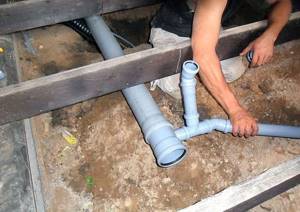
The size of the slope depends on the diameter of the pipes being laid:
- for those with a large 150 mm cross-section - about 8 mm per linear meter;
- for medium-sized products with a cross-section of 100 - 110 millimeters, approximately 20 millimeters;
- for products with a minimum 50 mm cross-section - 30 mm.
When installing plumbing fixtures at your dacha yourself, experts advise placing water seals on the equipment, which serve as an obstacle to unpleasant sewer odors. It is recommended to install sinks and showers high, and the toilet at the lowest point, as close as possible to the riser.
In a standard diagram for connecting a sink to a drainage system, the optimal diameter of the pipes laid to the riser is 50 millimeters, and the riser itself is 100 or 110 millimeters.
The sequence of assembling the pipelines and their connections may differ, but, as a rule, first of all, they install the riser, and then pipes are brought to it, and only after that the plumbing fixtures are connected.
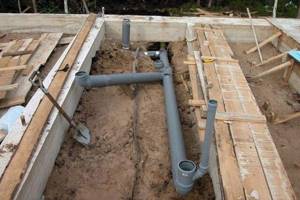
If a solid fuel or gas boiler is installed in a country house and a hot water supply system is running, the minimum set, consisting of a toilet and sink, is supplemented with a bath or shower. Then the internal wiring of an autonomous sewage system for a dacha turns out to be much more complicated.
At the end of the arrangement of the intra-house pipeline, an adapter is installed into the wall of the building in the form of a protective metal sleeve. The ideal way to remove the pipe is to create a hole in the foundation of the house, which should be located below the freezing level of the soil.
Rules for laying external pipes
The conditions for proper installation of a sewer system in a country house with your own hands is not only the selection of high-quality pipe products that connect intra-house communications with a septic tank or cesspool, but also compliance with the relevant rules and regulations that should be followed when laying pipes in the ground.
One of them states that when determining the depth of the trench, the level of soil freezing must be taken into account, since the pipes are laid below this mark. This is required so that liquid sewage at sub-zero temperatures does not begin to freeze and damage the pipeline.
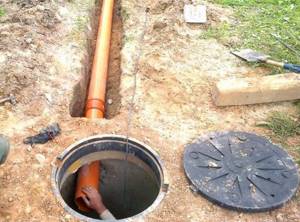
At the same time, the depth should not be too great, since when laying the main line, a slope of at least 2 centimeters per 1 meter of trench length must be maintained. As a result, it turns out that with a 10-meter ditch length, the difference between the initial and final values of this parameter will be equal to 20 centimeters.
When the length of the external pipeline exceeds 10 meters, has turns or joints, inspection wells are installed at the bends and joints of the pipes, designed to monitor the condition of the system and eliminate blockages.
To avoid having to dig very deep trenches when laying an autonomous sewer system on a site, even in regions with harsh climatic conditions, drainage lines are placed in the ground at a distance of 50-70 centimeters from its surface, and all areas of the structure are carefully insulated.
The following are used as thermal insulation materials:
- foam boxes;
- basalt fiber;
- polystyrene foam shell;
- penoizol;
- expanded clay backfill;
- mineral wool;
- foamed polyethylene.
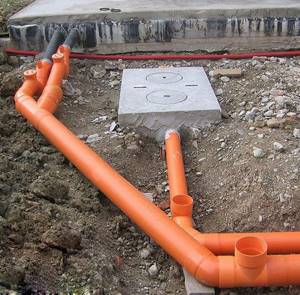
In northern areas of residence, the above materials are combined in order to increase the efficiency of thermal insulation. For example, first the pipes are covered with foam insulation, and then sprinkled with expanded clay on all sides.
There is another method of heating pipelines, the implementation of which will require laying an electrical cable. But it usually makes sense to use energy-dependent insulation for houses in which residents live permanently.
For country houses, where the owners visit very rarely during the cold season, the use of one of the insulation materials will be sufficient. But, if the pipes still freeze at sub-zero temperatures and a plug of ice forms in them, you can try to break through it with boiling water.
Sewage with cleaning functions
The best way to make a sewer system for a country house is a septic tank. The design includes several containers.
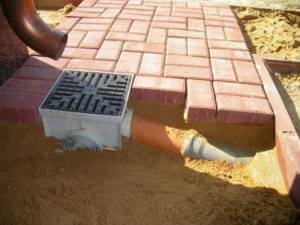
First, the water enters the first reservoir. Here the separation of liquid and sediment occurs. Due to a gradual increase in the level, wastewater enters another container, where its purification is completed.

In this state, the liquid is transferred to the soil. When planning the installation of a septic tank, it is important to consider the volume of the structure, as well as the need to periodically remove solid sediment.
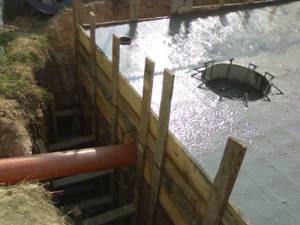
An improved option for a turnkey septic tank are local treatment stations or automatic installations. The volume of the tanks here is reduced due to electronic control.
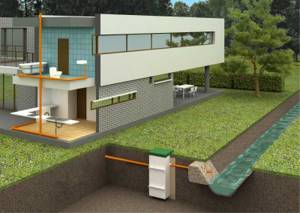
As a result, the system cannot function without electricity for more than four hours. Other disadvantages are restrictions on wastewater discharge and high price.
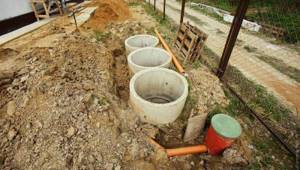
Construction of a cesspool
The list of works and timing of arrangement of drainage pits depend on their type. For example, if you need to make a simple sewer system in your country house with your own hands using a factory-made plastic container, the work can be completed in just 1 day. When it is planned to erect a monolithic structure from concrete mortar, installation will take at least a month.
Simultaneously with its construction, you can construct a trench and lay a pipeline. The size of the hole must correspond to the parameters of the storage tank, but on each side it is necessary to leave approximately 30 centimeters for backfilling the object. When determining the volume of the container, the household needs of the people living in the house are taken into account.

It is important to choose the right cesspool design; a lot of things will depend on this in the future. One of the methods for arranging a cesspool is to create a storage tank from concrete rings. To use a tank in a summer cottage, 2-3 products are usually sufficient, provided that it is planned to be filled to 1/2 or 1/3 of the volume, and the level of waste liquid cannot rise above the location of the inlet.
To excavate soil from a pit, special equipment is used or shovels and buckets are used. After the lower part has been cleared, it is reinforced with drainage made of sand and gravel 20 - 40 centimeters high.
When the tank is light in weight, experts recommend laying a concrete slab on the bottom or pouring a concrete screed, to which the tank is attached with anchors and thereby giving it a stable position. For a similar purpose, when backfilling the finished structure with soil, dry cement can be added to it to create a waterproof ring around the tank.
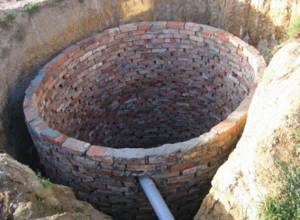
Structures built from rings, bricks and cinder blocks must be covered with two waterproofing layers on the outside and inside. These measures prevent the contents of the storage tank from entering the soil, where it penetrates into groundwater.
If the sewage system in a dacha is drained into a cesspool, it is necessary to install a ventilation riser, which is designed to remove gases to the outside. After completing the work and connecting the storage tank to the sewer pipeline, backfilling is carried out and the neck design begins. The upper technical hole is securely closed with a durable lid.
The difference between a septic tank and a cesspool
Many owners of modern suburban buildings strive not only to equip an efficiently functioning sewage system with a cesspool, but also to combine the accumulation and partial treatment of wastewater in their country house. The only solution to reduce the number of calls for sewer trucks is to install a factory-made or home-made septic tank instead of a cesspool.
It comes in two types:
- With water purification up to 68 - 97 percent using anaerobic and aerobic bacteria.
- With the processing of waste liquid by settling it and using anaerobes.
In the first case, it is equipped with a filter well, infiltration and filtration field, which carry out ground purification of waste water and sewage. When aerobes are involved in the operation of a septic tank, a compressor is installed in the second compartment to supply air and a special load is used for the full functioning of bacteria.
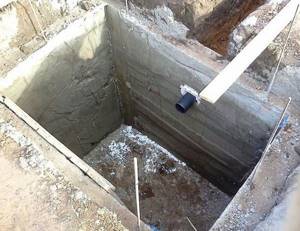
For them, the nutrient medium is a suspension of clarified wastewater from the sewer system, which has moved through the overflow into the second chamber. Water from septic tanks with aerobic treatment comes out as purified as possible, after which it can be drained into the ground without additional treatment or discharged onto the terrain.
The second option is a dual-chamber drive. One of its chambers is intended for settling the liquid and dividing it into fractions, and the second is used for filtering clarified water. The first compartment is cleaned with the same frequency as wastewater is removed from cesspools. Dirt from the second is removed less frequently. Typically this process is a replacement of the gravel filter used as the bottom.
We should not forget that over time, activated sludge accumulates in septic tanks, which is used as a fertilizer for the soil. The contents collected in the cesspool are also used, but only after following the peat technology for processing sewage.
Biological treatment stations are characterized by maximum efficiency, but it is not practical to purchase an expensive installation for a house where people live temporarily. Next, as an example of how to properly make a septic tank in a country house, the procedure for its construction from concrete blanks produced in a factory will be considered.
Wastewater disposal methods
The cesspool is increasingly being replaced by country sewerage without pumping; building such a structure with your own hands is not too difficult, and the efficiency and ease of use are an order of magnitude higher. Various types of septic tanks can be purchased ready-made, saving time on construction, but spending more money. An even more advanced option is a local treatment plant, an expensive, but capable of complete biological treatment of wastewater equipment. The choice should be made taking into account individual conditions - it is not always advisable to install the most expensive structure.
- Until now, a cesspool can be considered a cheap alternative to a septic tank if we are talking about a summer cottage where people come for a few hours, and the house does not have water-consuming equipment. The frequency of calling a sewer truck in this case will be acceptable, and the costs will be minimal. With proper independent installation of such a sewage system at your dacha and the use of specialized biological preparations, you can even avoid a strong unpleasant odor.
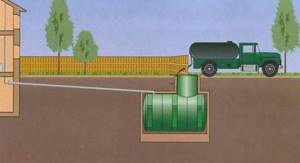
A sealed plastic sewer tank is a more advanced version of a cesspool, but everything also needs to be pumped out - Septic tanks, depending on the design, may or may not require pumping, however, in any case, they are more effective - impurities in such devices are deposited, processed by aerobic or anaerobic bacteria, filtered through a layer of gravel at the bottom of the drainage well or through a filtration field. Most of them provide a certain amount of clean water and sludge, which needs to be cleaned out of the tanks quite rarely. Depending on the volume and quality of cleaning, septic tanks can be used both for summer cottages and for permanent residences.
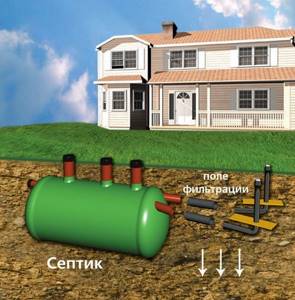
Septic tank with wastewater discharge to filtration fields
- VOC with complete wastewater processing - expensive equipment (the degree of purification is 98-100%). Such an autonomous sewer system is not needed in a country house with periodic visits, but not every owner can purchase such a design for a private house.
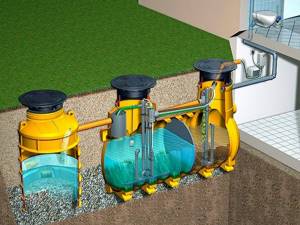
Deep cleaning station
As a result, how to make a sewer system with your own hands for a summer residence is decided individually in each specific case.
Stages of arranging a septic tank made of concrete rings
The assembly of the treatment structure from cylindrical blanks is carried out according to the standard scheme of a septic tank in the country. This process is simplified by the fact that the parts are large. At the same time, manipulations with concrete rings, which have significant weight, require the use of special equipment and the hiring of a team of workers.
To create a treatment plant, you need to purchase 2 sets of parts, since it consists of two separate tanks. The first of them is intended to perform a storage function, and the other - a filtering function. First you need to dig a pit. Its development can be simplified and accelerated by the use of special equipment.
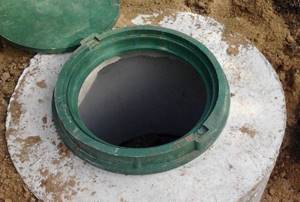
The process of creating a septic tank from concrete rings consists of successive stages:
- A pit is formed for the installation of a concrete septic tank.
- If the soil is loose, strengthen the dug hole.
- The starting element of the first chamber is installed.
- The first part of the structure is assembled.
- Assemble a chamber with a permeable bottom.
- The ceiling of the concrete chambers is installed.
- Narrow rings equipped with sealed hatches are installed.
After the construction of the septic tank is completed, a filtration field is organized.
Tires as a replacement for concrete rings
The most budget-friendly option for a septic tank can be built from old tires. They will be a free alternative to concrete rings. They will need to be trimmed and placed one on top of the other to create a semblance of a container. Around such a structure you will need to make a gravel sprinkling to fill the voids between the pit and the rubber.
Such a device is not hermetically sealed, so it cannot be used for a long time in all types of soil. It is suitable for easily absorbent sandy and rocky soils.
The design feature of such septic tanks makes it possible not to use filtration fields, however, the likelihood of environmental pollution is an order of magnitude higher than that of other analogues.
It is worth noting that the tires will need to be the same size, without extra holes. The internal parts at the top and bottom will need to be cut with a jigsaw or grinder.
Preparation of the pit according to the parameters of the structure
When arranging a country sewer system without pumping with your own hands, in a certain place provided for in the project, using shovels and a winch or a mini-excavator, dig a hole with a depth equal to the height of 2-3 rings and the neck.
To this design parameter add 30 to 40 centimeters to create the base. It consists of a layer of sand 15-20 centimeters thick and a layer of gravel or river pebbles, or crushed stone 15-20 centimeters in size. The arrangement of drainage ensures the presence of a reliable foundation and a filtering “cushion”.
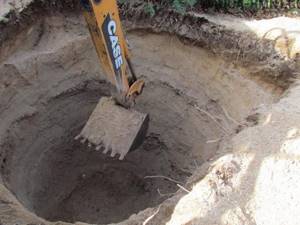
The length of the ditch should allow the installation of two tanks in it, which are connected to each other by a short overflow. The soil from the dug hole should not be removed from the summer cottage, since it is used for backfilling. The remaining land can then be used to form, for example, flower beds or other landscape objects.
Installation of concrete products
Factory-produced rings are installed one on top of the other, fastening them together at the joints with staples and sealing them with special gaskets. In order to simplify the installation of the lower element of the storage tank, the manufacturers of this product have created a product with a solid bottom that does not need to be weighted.
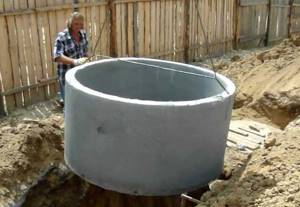
One or two more rings are placed on it, then it is covered with a ceiling that has a hole, and a neck is placed on top and, finally, a technical hatch is installed that is closed with a lid. To install concrete blanks, there is no need to make special calculations, since their dimensions are standard and you can always find out from the manufacturers how much wastewater the selected combination of concrete products can accommodate.
Waterproofing the septic tank structure
A concrete treatment facility made of separate rings must be waterproofed.
Use one of two methods:
- Application of insulating material to internal and external surfaces.
- Creating insulation on the outside, and finishing the seams on the inside.
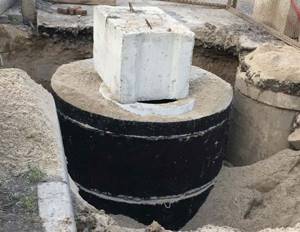
There are modern deep penetration waterproofing materials on sale that have technical characteristics superior to the bitumen layer, for example, Penetron. They are expensive products.
Connecting the septic tank to the pipes
When a sewer system is being installed in a country house, the fully installed treatment facility is combined into a single structure and connected to a pipeline coming from the house. For this purpose, holes are made in the concrete rings to create an overflow in the form of a short piece of pipe and another hole for the entrance of the sewer line.
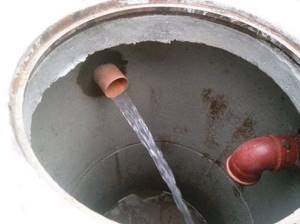
These elements are connected to each other as tightly as possible and covered with waterproofing.
The ventilation riser is brought outside. Next, in order to check the functionality and tightness of the septic tank, the first tank is filled with water. When the first wastewater enters the storage tank, a bioactivator is used to ensure a more efficient waste processing process. Not every home craftsman has the engineering knowledge and skills required to install an autonomous sewer system. Therefore, if you have doubts about your own capabilities, it is better to seek the services of professionals.
